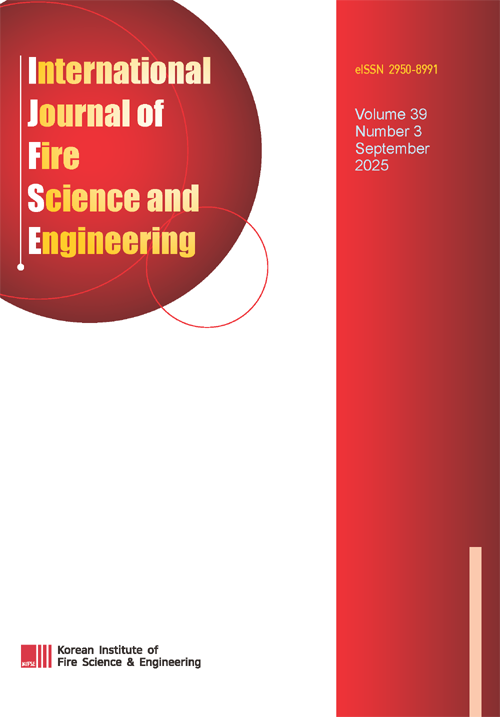학술논문
Impact of Particle Size Variation on Smoke Transport and Wall Deposition
이용수 0
- 영문명
- 발행기관
- 한국화재소방학회
- 저자명
- Ter-Ki Hong Seul-Hyun Park
- 간행물 정보
- 『International Journal of Fire Science and Engineering』Vol. 39, No. 3, 1~13쪽, 전체 13쪽
- 주제분류
- 공학 > 공학일반
- 파일형태
- 발행일자
- 2025.09.30
4,360원
구매일시로부터 72시간 이내에 다운로드 가능합니다.
이 학술논문 정보는 (주)교보문고와 각 발행기관 사이에 저작물 이용 계약이 체결된 것으로, 교보문고를 통해 제공되고 있습니다.

국문 초록
Accurate prediction of smoke transport and wall deposition is critical to fire safety design. This study systematically analyzed the effects of smoke particle size variation on fire dynamics simulator (FDS)-based smoke transport and wall deposition predictions. Experimentally, the particle size distribution (PSD) generated during the combustion of acrylonitrile-butadiene-styrene (ABS) was measured using a high-performance particle counter (GRIMM 11-D). Measurements were performed in the near-flame region (5 cm) and the upper plume region (50 cm), with the mass mean aerodynamic diameter (MMAD) measured at 1.03 and 10.04 μm, respectively. The measured MMAD values were applied in the FDS numerical model that simulated the transmission cell (TC), a key component of the gravimetric and simultaneous light extinction (GSLE) experimental device, to perform simulation. The flow conditions inside TC were fixed at an air/smoke mixture inflow rate of 6.6 L/min and a wall temperature of 25 °C. Smoke particle transport and bottom wall deposition behavior was then compared and analyzed. Simulation results showed that under the MMAD 10.04 μm condition, the average smoke concentration inside TC (ρYs) decreased rapidly owing to gravitational settling, whereas the MMAD 1.03 μm condition maintained more stable concentration characteristics. In addition, the cumulative mass of the smoke particles deposited on the bottom wall of TC was significantly higher under the large particle condition (5.28 mg) than that under the small particle condition (0.14 mg). Sectional analysis of deposition revealed that larger particles tend to accumulate near the TC inlet. This study confirmed that incorporating measurement-based PSD variation into the FDS model causes significant differences in smoke transport and wall deposition, even under the same conditions. This indicates that significant errors may occur in smoke concentration and deposition predictions during actual fire situations if particle size is entered as a fixed value in FDS simulation. Therefore, input that reflects smoke particle size variation is essential to enhance the reliability of fire simulation.
영문 초록
목차
1. Introduction
2. Experimental and Numerical Setup
3. Results and Discussion
4. Conclusion
Author Contributions
Conflicts of Interest
Acknowledgments
References
키워드
해당간행물 수록 논문
- International Journal of Fire Science and Engineering (IJFSE) Vol.39, No.3 Contents
- Impact of Particle Size Variation on Smoke Transport and Wall Deposition
- Impact of Pyrolysis Behavior and Residue Formation on Fire Growth Predictions in Polymer Fires
- Comparative Assessment of YOLO Segmentation Extensions for Intelligent Fire Detection
- A study on Quadruped Firefighting Robot Tactics for Supporting Life Search and Fire Suppression Activities at Firefighting Sites
- Evaluation of Satisfaction and Practical Effectiveness of GIS-Based Firefighting Training Systems among Firefighters
- The Effect of Escalator Height on Fire and Disaster Evacuation in Buildings: A Simulation-Based Approach
- Statistical Analysis of Fire Probability on Japanese Housing with Socio-Technical Observation
참고문헌
관련논문
공학 > 공학일반분야 BEST
- 리튬이온배터리화재 대응방안의 실효성 분석을 위한 실규모 화재진압실험
- 구조방정식 모형을 활용한 교과 문해력 함양과 복합양식 텍스트 독서 연구
- 융합교육 문헌 고찰을 통한 유아융합교육과정 제안
공학 > 공학일반분야 NEW
- International Journal of Fire Science and Engineering (IJFSE) Vol.39, No.3 Contents
- Impact of Particle Size Variation on Smoke Transport and Wall Deposition
- Impact of Pyrolysis Behavior and Residue Formation on Fire Growth Predictions in Polymer Fires
최근 이용한 논문
교보eBook 첫 방문을 환영 합니다!

신규가입 혜택 지급이 완료 되었습니다.
바로 사용 가능한 교보e캐시 1,000원 (유효기간 7일)
지금 바로 교보eBook의 다양한 콘텐츠를 이용해 보세요!



